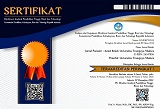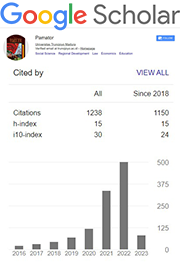The Effect of Waiting Time, Accessibility, Perception of Risk, Feeling Benefit on The Intention to Reuse Halodoc App
Abstract
Health services in Indonesia have undergone significant changes. Post-pandemic, health services have had to adjust to changes. Health systems around the world have faced unprecedented challenges as a result of the pandemic. The more advanced and rapid information technology and supported by the post-pandemic world that is our focus, further needs must be met with digital interaction, with the aim of making it easier for people to carry out various activities. The purpose of this study is to ascertain how patient attitude, perceived benefits, risk perception, waiting time, and accessibility affect the intention to re-use the Halodoc application. This study employs quantitative techniques. The population of this study were people who had used the Halodoc App. Researchers distributed 116 questionnaires with 103 responses. This study uses multiple linear regression analysis techniques. Based on the t test results, it shows that the value of waiting time, accessibility, perceived risk, perceived benefits have a significant effect on the intention to reuse the Halodoc App.
Keywords
Full Text:
PDFReferences
Ancker, J. S., Y. Barrón, & M. L. Rockoff. (2011). Use of An Electronic Patient Portal Among Disadvantaged Populations. Journal of General Internal Medicine, 26(10), 1117-23.
Bolton, R. N. & J. H. Drew. (1991). A Multistage Model of Customers Assessments of Service Quality and Value. Journal of Consumer Research, 17(4), 375-385.
Camacho, F., R. Anderson, A. Safrit, A.S. Jones, & P. Hoffmann. (2006). The Relationship Between Patient’s Perceived Waiting Time and Office- Based Practice Satisfaction. North Carolina Medical Journal, 67(6), 409-413.
Carroll, A. E., F. P. Rivara, B. Ebel, F. J. Zimmerman, & D. A. Christakis. (2005). Household Computer and Internet Access: The Digital Divide In A Pediatric Clinic Population The Regenstrief Institute For Health Care , Indianapolis , IN. Symposium is a Quarterly Journal Modern Foreign Lierature, 17(5), 111-115.
Chang, B. L., S. Bakken, & S. S. Brown. (2004). Bridging The Digital Divide: Reaching Vulnerable Populations. Journal of the American Medical Informatics Association, 11(6), 448-457.
D’Anza, B., & J. P. Peter. (2022). Unlocking Value in a Post Pandemic World. Population Health Management, 25(1), 11-22.
Dabholkar, P. A. (1996). Consumer Evaluation of New Technology Based Self-service Options: An Investigation of Alternative Models of Service Quality. International Journal of Research in Marketing, 13(1), 29-51.
Dansky, K. H., & J. Miles. (1997). Patient Satisfaction With Ambulatory Healthcare Services: Waiting Time and Filling Time. Hospital and Health Services Administration, 42(2), 165-177.
David, A. T., M.D, R.Y. Paul, P.h.D. R. Diana, M.D. Williams, L.A. Stephen, & M.D. (1996). Effects of Actual Waiting Time, Perceived Waiting Time, Information Delivery, and Expressive Quality on patient Satisfaction in the Emergency Department. Administration/Original Contribution. 28(6), 657-65.
Deng, Z., Z. Hong, C. Ren, W. Zhang, & F. Xiang. (2018). What Predicts Patients' Adoption Intention Toward Mhealth Services in China: Empirical Study. JMIR Mhealth Uhealth, 6(8), 1-14.
Fennell, K. M., D. A. Turnbull, N. Bidargaddi, J. L. McWha, M. Davies, & I. Olver. (2017). The Consumer-Driven Development and Acceptability Testing af A Website Designed to Connect RuralCancer Patients and Their Families, Carers and Health Professionals with Appropriate Information and Psychosocial Support. European Journal of Cancer Care, 26 (5), 12533.
Fox, S., & M. Duggan. (2013). Health Online. Pew Internet & American Life Project. 7(3), 17-25.
Goel, M. S., T. L. Brown, & A. Williams. (2011). Disparities in enrollment and use of an electronic patient portal. Journal of General Internal Medicine, 26(10),1112-6.
Harris, L. T., S. J. Haneuse, & D. P. Martin. (2009). Diabetes quality of care and outpatient utilization with electronic patient–provider messaging. Journal Diabetes Care, 32(7), 1–5.
Hsu. J., J. Huang, & J. Kinsman. (2012). Use of e-Health services between 1999 and 2002: a growing digital divide. Journal of the American Medical Informatics Association, 12(2), 164-171
Jha, A. K., C. M. DesRoches, & A. E. Shields,. (2009). Evidence of an emerging digital divide among hospitals that care for the poor. Journal Health Affairs (Project Hope), 28(6), 1160-70
Khatun, F., A.E. Heywood, P.K. Ray, S.M. Hanifi, A. Bhuiya, & S.T. Liaw. (2015). Determinants of readiness to adopt m-Health in a rural community of Bangladesh. International Journal Medical Informatics, 84(10), 847–856.
Klaver. N., J. V. D. Klundert, R. V. D. Broek, & M. Askari. (2021). Relationship Between Perceived Risks of Using mHealth Applications and the Intention to Use Them Among Older Adults in the Netherlands: Cross-sectional Study. JMIR Mhealth Uhealth, 9(8), 1-12.
Laura, C., M. D. M. P. H. Myers, M. D. N. G. Kevin, P. M. P. H. Colleen, A. D. B. S. Kathleen, K. P. H. D. Patricia, X. L. M. D., & M. S. C. Vincent. (2023). Trends in Outpatient Visits and Hospital and Intensive Care Uunit Admissions of Adults With Covid-19 in an Integrated US Health Care System, March 2020to January 2022. Journal of Applied Managerial Accounting, 6(1), 2253269.
Marasinghe, R. B., S. Edirippulige, & D. Kavanagh. (20120. Effect of Mobile Phone- Based Psychotherapy In Suicide Prevention: A Randomized Controlled Trial In Sri Lanka. Journal Telemed Telecare, 18(3), 151–155.
Meuter, M. L., A. L. Ostrom, R. I. Roundtree, & M. J. Bitner. (2000). Self service Technologies: Understanding Customer Satisfaction with Technology-based Encounters. Journal of Marketing, 64(3), 50 - 64
O’Cass, A., & J. Carlson. (2012). An Empirical Assessment of Consumers Evaluations of Web Site Service Quality: Conceptualizing And Testing A Formative Model. Journal of Services Marketing, 26(6), 419–434.
Park, J., J. Lee, H. Lee, & D. Truex. (2012). Exploring The Impact of Communication Effectiveness on Service Quality, Trust and Relationship Commitment In IT Services. International Journal of Information Management, 32(5), 459–468.
Perrin, A., & M. Duggan. (2015). As Internet Use Nears Saturation For Some Groups, a Look at Patterns of Adoption. Pew Research Center. America.
Probst, J.C., D. L. Greenhouse, & A. W. Selassie. (1997). Patient and Physi-Cian Satisfaction With An Outpatient Care Visit. The Journal of Family Practice, 45(5), 418-425.
Quaosar, G. M. A., H. Rakibul, & B.Yukun. (2018). Investigating Factors Affecting Elderly’s Intention to Use M-Health Services: An Empirical Study. Journal Telemedice and Health, 24(4), 1-6.
Rai, A., L. Chen, J. Pye, & A. Baird. (2013). Understanding Determinants of ConsumerMobile Health Usage Intentions, Assimilation, and Channel Preferences. Journal of Medical Internet Research, 15(8), 1-20.
Ralston, J.D., I.B. Hirsch, J. Hoath, M. Mullen, & A. Cheadle. (2009). Web-based collaborative care for type 2 diabetes. Journal Diabetes Care, 32(2), 234–239.
Reardon, J. & D. E. McCorckle. (20020. A Consumer Model for Channel Switching Behaviour. International Journal of Retail and Distribution Management, 30(4), 179-185.
Ren, C., Z. Deng, Z. Hong, & W. Zhang. (2019). Health Information in The Digital Age: an Empirical Study of The Perceived Benefits and Costs of Seeking and Using Health Information From Online Sources. Journal Health Information and Libraries, 36(4), 153-167.
Roblin, D. W., T. K. Houston, J. J. Allison, P. J. Joski, & E. R. Becker. (2009). Disparities In Use of A Personal Health Record In AManaged Care Organization. Journal of the American Medical Informatics Association, 16(5), 683-9.
Rosen, P., & C. K. Kwoh. (2007). Patient–Physician E-Mail: An Opportunity to Transform Pediatric Health Care Delivery. Pediatrics, 120(4), 701-6.
Sarkar, U., A. J. Karter, & J. Y. Liu. (2011). Social Disparities In Internet Patient PortalUse In Diabetes: Evidence That The Digital Divide Extends Beyond Access. Journal of the American Medical Informatics Association, 18(3), 318-21.
Wolfinbarger, M. & M. C. Gilly. (2002). comQ: Dimensionalising, Measuring and Predicting Quality of The E- tail Experience. Working Paper No. 02-100, Massachusetts Marketing Science Institute.
Yamin, C. K., S. Emani, & D. H. Williams. (2012). The Digital Divide In Adoption And Use of A Personal Health Record. Archives Internal Medicine, 171(6), 568- 74.
Yu, D. X., B. Parmanto, B. E. Dicianno, & G. Pramana. (2015). Accessibility of mHealth Self-Care Apps for Individuals with Spina Bifida. Perspectives inHealth Information Management, 1(12), 26755902.
Zeithaml, V. A. (1988). Consumer Perceptions of Price, Quality and Value: A Meansends Model Of and Synthesis Of Evidence. Journal of Marketing, 52(3), 2-22.
Zhou, Y.Y., M. H. Kanter, J. J. Wang, & T. Garrido. (2010). Improved Quality At Kaiser Permanente Through E-Mail Between Physicians and Patients. Health Affairs (Project Hope), 29(7), 1370-5.
DOI: https://doi.org/10.21107/pamator.v18i1.29414
Refbacks
- There are currently no refbacks.
Copyright (c) 2025 Firza Fahriza, Didit Darmawan

This work is licensed under a Creative Commons Attribution-ShareAlike 4.0 International License.
Jurnal Pamator : Jurnal Ilmiah Universitas Trunojoyo by Universitas Trunojoyo Madura is licensed under a Creative Commons Attribution-ShareAlike 4.0 International License.















.png)